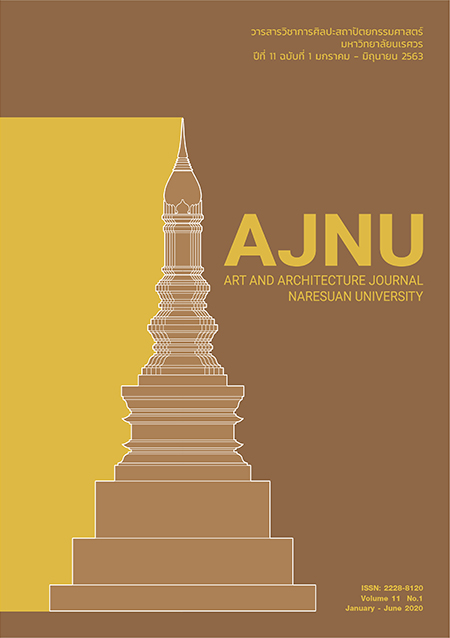Guidelines for Improving the Physical Environment in Public Area of the Kwan Phayao to Support the Elderly's Activities
Main Article Content
Abstract
The research is the study of the physical environments for the elders in the Kwan Phayao public area, divided into two parts: part 1 concerning survey as a research tool to explore the physical features of the area and part 2 about a questionnaire to explore activity and elders’ needs who used the area.The findings are summarized that physical appearances are both supportive and unaccommodating for elders’ activities as being without parking lot, signs, three-dimensional diagram and with nonstandard ramps. Besides, ramp and staircase have no guard rail and road connection in several areas. There is no toilet in the area, but with nonstandard toilet nearby. Seats are without backrest in the risky area, including uneven, obstructive surface of roads without tactile surface. Most elderly who use the area are couples living in Phayao, retirees, unemployed, and domestic workers. Most used the space 3-5 days a week in the evening. Causes of inconvenient reason are rain and childcare. Most walked in the area for jogging and exercises, and their satisfaction for using the area is at a low level. Based on the findings, the guideline is proposed: additional activity area should be provided for the diversity in use for all ages and increasing the spot of crossing, such as crosswalks, crossing signal, and fixing the ramp to allow the wheelchair to be used. Physical characteristics unfound or do not meet the criteria used for studying physical features of the area can be improved to meet the criteria by considering the convenience, safety and context of the area. The improvement of such physical characteristics will make public areas along the Kwan Phayao as a model for the management of the area to support the use of the area of the elderly, which will help promote tourism of Kwan Phayao.
Article Details
References
กฎกระทรวงกำหนดสิ่งอำนวยความสะดวกในอาคารสำหรับผู้พิการหรือทุพพลภาพและคนชรา พ.ศ. 2548.
(2548, 2 กรกฎาคม). ราชกิจจานุเบกษา. 122 52ก.
คณะกรรมการผู้สูงอายุแห่งชาติ. (2553). แผนผู้สูงอายุแห่งชาติ ฉบับที่ 2 (พ.ศ.2545-2564).ฉบับปรับปรุงครั้งที่ 1 พ.ศ.2552. กรุงเทพฯ: โรงพิมพ์เทพเพ็ญวานิสย์.
เทศบาลเมืองพะเยา. (2561). ข้อมูลทั่วไปของเทศบาลเมืองพะเยา. สืบค้น 05 พฤศจิกายน 2561, จาก http//www.tessabanphayao.go.th
ปรารถนา ศิริเบ็ญนรัต. (2553). รูปแบบการท่องเที่ยวของผู้สูงอายุที่เป็นข้าราชการบำนาญในเขตเทศบาล จังหวัดนครปฐม (วิทยานิพนธ์ปริญญาบริหารธุรกิจมหาบัณฑิต). กรุงเทพฯ: มหาวิทยาลัยศิลปกร.
ศักดิธัช เสริมศรี. (2554). สภาพแวดล้อมที่เหมาะสมกับการออกกำลังกายของผู้สูงอายุในพื้นที่ สาธารณะเขตเทศบาลนคร เชียงใหม่ (วิทยานิพนธ์ปริญญาสถาปัตยกรรมศาสตรมหาบัณฑิต). เชียงใหม่: มหาวิทยาลัยเชียงใหม่.
สมาคมสถาปนิกสยามในพระบรมราชูปถัมภ์. (2552). คู่มือปฎิบัติวิชาชีพ การออกแบบสภาพแวดล้อมและสิ่งอำนวยความ สะดวกสำหรับทุกคน (Universal Design Code of Practice). กรุงเทพฯ: บ.พลัสเพรส จำกัด.
สำนักงานคณะกรรมการพัฒนาการเศรษฐกิจและสังคมแห่งชาติ. (2556). การคาดประมาณประชากรของประเทศไทย ปี 2553-2583. กรุงเทพฯ: โรงพิมพ์เดือนตุลา.
สำนักพัฒนาบริการท่องเที่ยว กรมการท่องเที่ยว. (ม.ป.ป.). คู่มือการจัดทำสิ่งอำนวยความสะดวกสำหรับนักท่องเที่ยวกลุ่มคน พิการและผู้สูงอายุ. กรุงเทพฯ: ม.ป.ท.
สํานักส่งเสริมและพิทักษ์ผู้สูงอายุ. (2553). คู่มือการจัดสภาพแวดล้อมที่เหมาะสมและปลอดภัย. กรุงเทพฯ: ม.ป.ท.
สุรีรัตน์ จำปาเงิน. (2559). แนวทางการพัฒนาสวนสาธารณะที่เหมาะสมเพื่อส่งเสริมเมืองที่เป็นมิตรต่อผู้สูงอายุ
(วิทยานิพนธ์ปริญญามหาบัณฑิต). กรุงเทพฯ: มหาวิทยาลัยธรรมศาสตร์.
สุรชาติ สินวรณ์. (2558). แนวทางการออกแบบสิ่งอำนวยความสะดวกและสภาพแวดล้อมทางกายภาพเพื่อส่งเสริมการท่องเที่ยว สำหรับผู้สูงอายุและพิการ ตลาดน้ำตลิ่งชัน. วารสารวิจัย มสด สาขามนุษยศาสตร์และสังคมศาสตร์,ปีที 11 ฉบับที่ 3 กันยายน - ธันวาคม 2558, 97-116.
สุดนิรันดร์ เพชรัตน์. (2557). การจัดสภาพแวดล้อมทางกายภาพเพื่ออำนวยความสะดวกสำหรับผู้สูงอายุ. วารสาร วิศวกรรมศาสตร์ มหาวิทยาลัยศรีนครินทรวิโรฒ ปีที่9 ฉบับที่2 เดือนกรกฎาคม – ธันวาคม พ.ศ.2557, 70-85.
Burgstahler, S. (2009). Universal Design of Instruction (UDI): Definition, Principles, Guidelines, and Examples.n.p.


